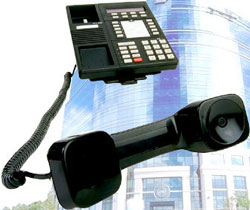By: John Shepler
What do all businesses have in common? Telephones. And what’s a common need for all business phone systems? Management. But imagine if you could eliminate that burden – wouldn’t that be fantastic and give your business a competitive edge? It certainly could. Let’s explore why, and more importantly, how.
 The Problem with Traditional Phone Systems
The Problem with Traditional Phone Systems
The traditional business phone is a bulky piece of equipment, filled with analog technology and tethered to the phone company with its own dedicated line. While modern phones are sleeker, incorporating digital components and cordless designs with multiple handsets, they still rely on their own separate wiring systems.
Managing a single phone or a cordless system with several handsets is straightforward. There’s not much to it. As long as you have a dial tone, you’re all set. The only addition you might consider is a backup battery for phones with AC adapters, as older analog models receive power directly from the phone line. Newer electronic phones, particularly cordless ones, have DC power supplies that plug into a wall outlet.
The real headaches arise when you have multiple phones sharing external lines. While each phone could have its own dedicated line, this quickly becomes expensive. Plus, not everyone needs to make external calls simultaneously. Some calls occur within the company, and many employees aren’t even on the phone at all times.
Business Phone System Options
The two most prevalent types of business phone systems are Key Telephone Systems (KTS) and Private Branch Exchanges (PBX).
KTS enable internal company calls using only your internal phone lines. This is a major advantage over individual phones, as phone companies charge for every call routed through their network. However, KTS have a limitation – each line requires a dedicated button on every phone for manual call selection. This typically restricts the practical number of outside lines to four or six.
PBXs function like miniature phone company switches within your business. Internal calls can be made through the PBX without using an outside line. The system efficiently manages a pool of external lines shared by all phones. The required number of lines depends on how many employees are making or receiving external calls concurrently. Often, a dozen lines can accommodate dozens of users.
Why Eliminate Your Phone System?
Within your company, someone (possibly you) bears the responsibility of managing phone expenses. These expenses encompass local and long-distance charges, the costs associated with purchasing and maintaining the phone system, as well as any moves, additions, or changes to your phone setup.
The costs tied to “moves, adds, and changes” stem from the fact that each phone has a dedicated line connected to the KTS or PBX. This connection informs the system which phone is in use or needs to ring. Relocating a phone to a different desk necessitates physically moving the connection in the phone wiring or reprogramming the system to recognize the new location. Otherwise, employees would have to change phone numbers every time they move. Adding a new phone means installing a phone jack and running a line back to the system.
As your company grows, so does the number of phones, the complexity of phone wiring, and the overall cost of the phone system. To make matters worse, if your business expands beyond the capacity of your current system, you’ll face either a costly upgrade or a complete system replacement. Eventually, technology becomes outdated, making it expensive or even impossible to maintain. This is when you’re faced with a significant capital investment.
Escaping the Phone System Dilemma
Unless you’re in the telecommunications industry, your core business likely doesn’t revolve around phone systems. Phones are simply a tool to facilitate your work. Even call centers prioritize the services they offer, not the phone equipment itself.
Imagine having the ability to purchase or lease phone sets as needed, plug them directly into your existing computer network, and delegate the responsibility of managing and maintaining expensive switching equipment to someone else.
This is possible with a service known as Hosted PBX or Hosted VoIP – both terms refer to the same concept. VoIP technology transforms phone sets into network peripherals. Similar to computers, phones have unique network addresses and can be plugged into any network jack without requiring wiring changes.
With Hosted PBX, there’s no need for a physical KTS or PBX on your premises. Instead, a much larger “cloud” system housed in the service provider’s data center handles your calls. Your on-site equipment consists only of SIP Phones and a specialized router or call controller that routes calls to the provider. Traditional phone lines are replaced with a digital SIP Trunk connecting your location to the provider.
The Pay-As-You-Go Advantage
By adopting this approach, you effectively trade a substantial upfront investment and ongoing maintenance costs for a predictable “cost per seat” model. Some providers even include new SIP phones with their service and provide additional phones as your business expands. This eliminates the need to pay upfront for equipment that may sit idle. Conversely, if you downsize, you simply return the phones and adjust your payment accordingly.
Advanced Functionality
It’s likely that your existing phone system lacks the capability to integrate smartphones or seamlessly connect with computers for efficient call center operations. You may also be missing features like auto attendants or hunt groups, which are essential for call centers. In contrast, a hosted system not only offers these advanced features but also ensures they remain current through regular updates. Since the system resides in the cloud, you’ll never have to worry about upgrading your phone system.
If you’re feeling restricted by the limited functionality, inflexibility, or high costs of your current phone system, it’s wise to explore Cloud Hosted PBX Business Telephone Service before committing to an expensive on-premise upgrade.

